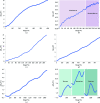Diffraction data analysis in the presence of radiation damage
- PMID: 20382996
- PMCID: PMC2852307
- DOI: 10.1107/S0907444909040177
Diffraction data analysis in the presence of radiation damage
Abstract
In macromolecular crystallography, the acquisition of a complete set of diffraction intensities typically involves a high cumulative dose of X-ray radiation. In the process of data acquisition, the irradiated crystal lattice undergoes a broad range of chemical and physical changes. These result in the gradual decay of diffraction intensities, accompanied by changes in the macroscopic organization of crystal lattice order and by localized changes in electron density that, owing to complex radiation chemistry, are specific for a particular macromolecule. The decay of diffraction intensities is a well defined physical process that is fully correctable during scaling and merging analysis and therefore, while limiting the amount of diffraction, it has no other impact on phasing procedures. Specific chemical changes, which are variable even between different crystal forms of the same macromolecule, are more difficult to predict, describe and correct in data. Appearing during the process of data collection, they result in gradual changes in structure factors and therefore have profound consequences in phasing procedures. Examples of various combinations of radiation-induced changes are presented and various considerations pertinent to the determination of the best strategies for handling diffraction data analysis in representative situations are discussed.
Figures





References
-
- Addlagatta, A., Krzywda, S., Czapinska, H., Otlewski, J. & Jaskolski, M. (2001). Acta Cryst. D57, 649–663. - PubMed
-
- Arnott, S. & Wonacott, A. J. (1966). Polymer, 7, 157–166.
-
- Banumathi, S., Zwart, P. H., Ramagopal, U. A., Dauter, M. & Dauter, Z. (2004). Acta Cryst. D60, 1085–1093. - PubMed
-
- Blake, C. C. F. & Phillips, D. C. (1962). Symposium on the Biological Effects of Ionizing Radiation at the Molecular Level, pp. 183–191. Vienna: International Atomic Energy Agency.
-
- Borek, D., Ginell, S. L., Cymborowski, M., Minor, W. & Otwinowski, Z. (2007). J. Synchrotron Rad.14, 24–33. - PubMed
Publication types
MeSH terms
Substances
Grants and funding
LinkOut - more resources
Full Text Sources
Other Literature Sources
Medical

